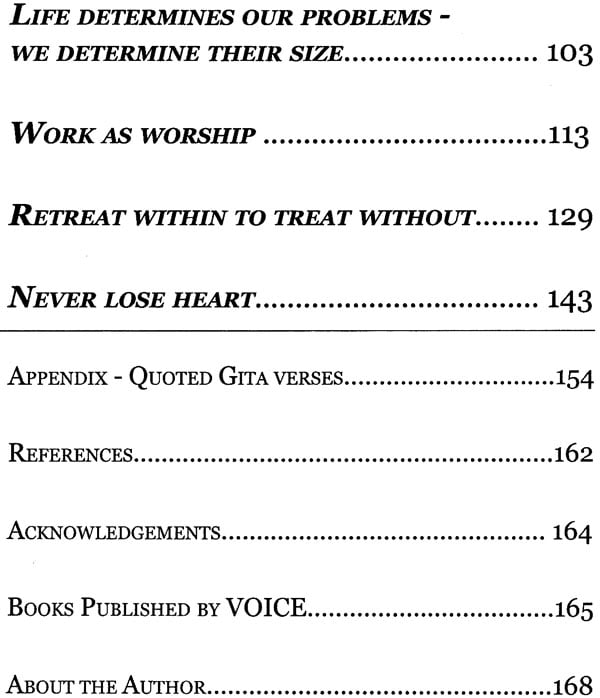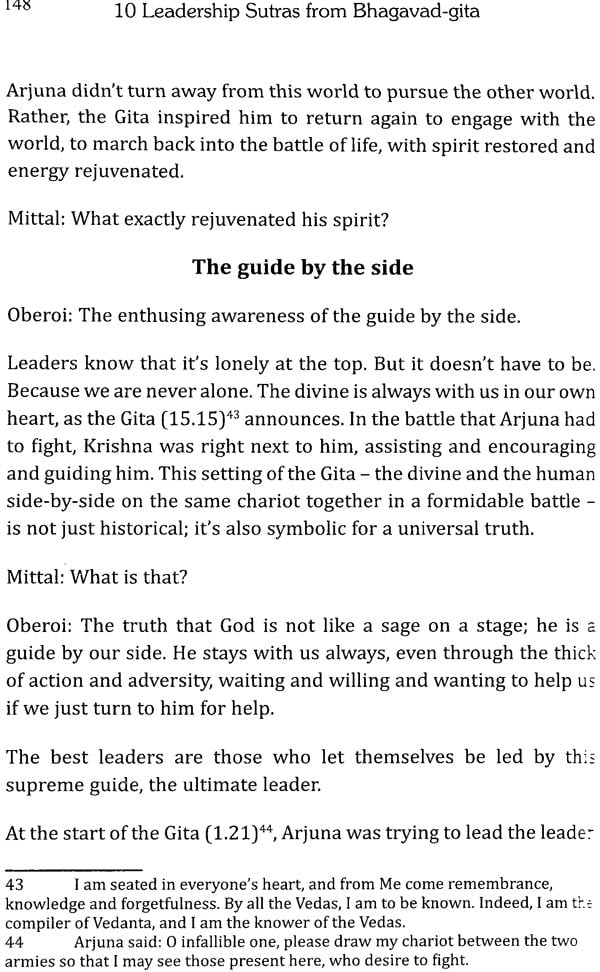
10 Leadership Sutras: From Bhagavad Gita
Book Specification
| Item Code: | NAQ616 |
| Author: | Chaitanya Charan |
| Publisher: | Vedic Oasis for Inspiration Culture & Education |
| Language: | English |
| Edition: | 2015 |
| Pages: | 176 |
| Cover: | PAPERBACK |
| Other Details | 8.50 X 5.50 inch |
| Weight | 200 gm |
Book Description
Chaitanya Charan is a monk and spiritual author. He has done his Electronics & Telecommunications Engineering from the Government College of Engineering, Pune. He subsequently served as a software engineer in a multinational software company. He also secured 2350 out of 2400 in the GRE exam, bagging the top rank in Maharashtra.
Seeing the prevent problems of stress, depression, addiction and overall misdirection -all caused by a lack of spirituality, he felt inspired to dedicate his life to the cause of sharing the spiritual wisdom of the Bhagavad-gita under the aegis of ISKCON (International Society for Krishna consciousness).
He is a member of ISKCON's topmost intellectual body, the Shastric Advisory Council, and is the associate-editor of ISKCON's global magazine, Back to Godhead.
He is the author of the world's only Gita-daily feature, wherein he writes daily a 300-word inspirational reflection on a verse from the Bhagavad-Gita. Till now he has written over 1200 Gita meditations that are posted on www.gitadaily.com and are read through daily feeds by thousands from all over the world.
His articles have been published in many national newspapers including Indian Express, Economic Times and Times of India in the Speaking Tree column. His writings in English have been translated into several foreign languages including German, Chinese and Romanian and several Indian languages including Kannada, Telgu, Bengali, Hindi and Marathi.
He is the author of fourteen books: ENERGY - Your Sutra for Positive Thinking; Science and Spirituality; The Spiritual Scientist series, volumes 1 and 2; Recession - Adversity or Opportunity?;Why do we need a temple?; Frequently Unanswered Questions; Idol Worship or Ideal Worship?; The Gita for Daily Enrichment; Oh My God! Re-answering the Questions; My Little Bhakti Companion; Timeless Insights on Today's Issues; 10 Leadership Sutras from Bhagavad-gita and GK for PK!.
"The Bhagavad-Gita is the most systematic statement of spiritual evolution of endowing value. to mankind. It is one of the most clear and comprehensive summaries of perennial philosophy ever revealed; hence its enduring value is subject not only to India but to all of humanity."
- Aldous Huxley
"You get the best effort from others not by lighting a fire beneath them, but by building a fire within."- Bob Nelson
Building the fire within others has to begin with building the fire within us. People learn far more from others' actions than their words. Unless we are ourselves inspired, we can't inspire others. It takes one flame to light another flame. This book is about lighting the flame within us.
Personal leadership - The foundation of public leadership
Authentic leadership is not a matter of designation - it is a matter of disposition. People may get positions, but those make them only nominal leaders. Without the right disposition, such leaders remain at best ineffective leaders, unable to channelize the resources and talents entrusted to them. At worst, they may become disastrous misleaders, who take themselves and their subordinates to ruination.
What is the right disposition that brings authenticity to the position of leadership?
The right disposition has many features, but they all need to be founded in one essential feature: self-mastery. This feature of leadership is often called personal leadership, as contrasted with public leadership. Whereas public leadership requires a gamut of talents that may or may not be present in everyone, personal leadership is within the reach of everyone.
This brings us to the oft-raised question, "Are leaders born or are they made?" The question often overlooks the reality that all of us just by being born are made into leaders, even if informally in our social circles. In his book Developing the Leader Within You, leadership consultant John C Maxwell writes, "Sociologists tell us that even the most introverted individual will influence ten thousand other people during his or her lifetime!"
Whether our public leadership role is formal or informal, we will succeed sustainably in it only when we are successful in our personal leadership.
Only when the blinders and distorters resulting from our biases, hang-ups and moods are removed can we inspire and direct others effectively. Those without self-mastery will end up under-using, if not abusing, their own talents and resources as well as those of their subordinates. To the extent we have learnt to discipline our own impulses, to that extent we will be able to see clearly and act wisely - both critical capacities for sound leadership.
The Gita's approach to leadership
The Bhagavad-gita offers an inside-out approach to leadership, for it counsels a conflicted leader to go deep within to the core of his self and find therein the wisdom to shoulder the demanding possibilities of leadership. It clearly positions personal leadership as the foundation of public leadership.
The Gita's bearing on leadership is evident from its setting itself. It is a conversation between two leaders on a leadership issue of momentous consequence. Krishna, who is the main speaker in the Gita, is a leader par excellence, having established himself as the foremost leader of his times. Rising from the obscurity of birth in a prison and childhood in a pastoral village, he rapidly rose in his early teens to the echelons of power by outwitting a tyrant who had rtest of warriors - both qualities that naturally marked him as a leader. Yet he chose to keep his repeatedly tried to assassinate him. He was widely acknowledged as the wisest of thinkers and the sma leadership unofficial, accepting the responsibilities of leadership without its facilities. Rather than becoming the king in his dynasty, as he was rightly entitled to, he chose the humble station of an advisor to the king. Even in the Kurukshetra war, prior to which the Gita was spoken, he voluntarily chose the menial role of a charioteer - something like a chauffeur in today's context. For an age with a surfeit of leaders who want to enjoy the privileges of position without discharging its responsibilities, Krishna is an excellent example of a leader who put contribution above position. Tradition considers him to be God himself descended to the earth to guide humanity.
Arjuna, the seeker in the Gita, is also an influential leader. He is a prominent prince in one of the most powerful ruling dynasties of the times. His claim to leadership stems not just from his dynasty but also from his virtuosity - he is the foremost archer in an age of formidable archers, the champion among champions.
Book's Contents and Sample Pages













